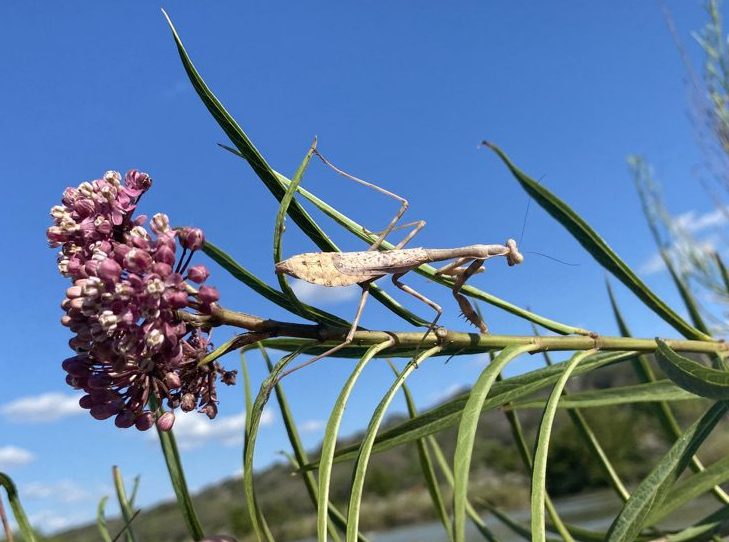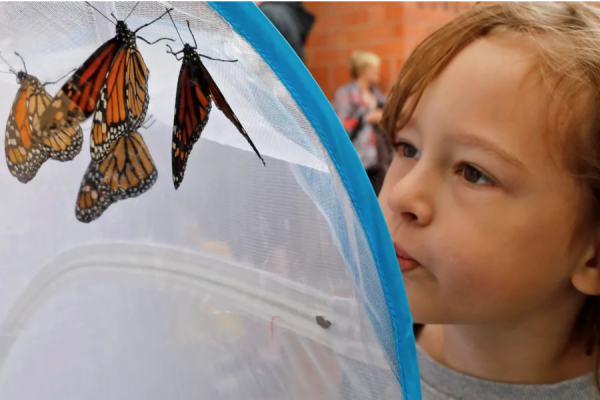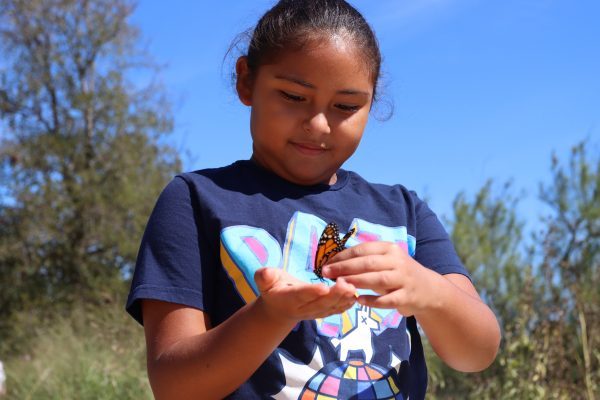What a difference five inches of rain makes.
The Llano River in the Texas Hill Country is known for exhibiting drama, running at a trickle during times of drought, then surging to flood stages that cause massive damage. This summer has been no exception. From running almost dry in parts in August to rushing strong in September, the mighty Llano has shown its resilience as grasses, forbes, wildflowers and butterflies have returned after a week of solid rain that followed months of drought.
That’s not to say that the dry spell is behind us. Five months of 100-degree days starting in May coupled with ZERO measurable rain since last September provoked flashbacks of the historic drought of 2011, which resulted in some of the lowest numbers ever recorded for the migrating monarch butterfly population.

Praying mantis on Swamp milkweed. They eat monarch butterflies. Photo by Monika Maeckle
The Texas Hill Country in 2022 flaunted a spring season that resembled autumn. Landscapes were brown, not green, and insects were few and far between. A harsh freeze led into a serious dry spell that cramped the landscape’s style, crippling wildflowers, drying up streams, and generally straining the ecosystem. But a slew of recent thunderstorms has demonstrated the Llano’s resilience. The river is back, and so are the grasses, flowers, and insects–including butterflies.
River and streambeds are a favorite roosting spot for migrating monarchs’ each fall. The riparian contexts provide shade, trees for roosting, water, and nectar sources. In the Texas Funnel in the late summer and fall, riverbeds are often the only places where flowers bloom, which makes them a popular rest stop for migrating monarchs.
—Photos by Monika Maeckle
While the recent storms provide a break from the dry and the heat, 2022’s harsh weather has exacted a steep price. Swamp milkweed, Asclepias incarnata, which struts its blooms each Labor Day, appeared strained this weekend, the usual pink umbels exhibiting a more reddish, dehydrated hue. Aphids, milkweed bugs, ladybugs and praying mantises riddled the plants, on which monarchs arriving in late summer often lay their eggs. Those eggs typically hatch in time to join the great migration in mid-October.
Many of the Swamp milkweeds observed this weekend had been abused by the rising waters precipitated by the dramatic rain and river rise. Their leaves, caked in mud and other river solvents, posed an unappealing place for monarch moms to lay their eggs.
Goldenrod, late flowering boneset, purple leather flower and other seasonal bloomers showed their colors, but not in the usual numbers seen most Labor Day weekends. One monarch was spotted flitting along the river. Three caterpillars and one egg were observed on dozens of milkweed stands.
How robust this year’s monarch migration will be remains to be seen.
Related Articles:
- Dejavu: is 2022’s dry spell setting the stage for another Texas drought like 2011?
- Forever Journey: honor someone who died by tagging a monarch butterfly in their name
- Caterpillar condos tap monarch butterfly migration for hands-on nature lessons
- Save the date: Monarch Butterfly and Pollinator Festival finds new roost at Brackenridge Park
- Three monarch butterflies tagged in honor of those who died recovered in Mexico
- Two monarchs tagged on the Llano River in honor of lost loved ones recovered in Mexico
- They’re here! Drought conditions greet monarch butterflies as they arrive in Texas
- Massive arrivals of monarch butterflies in the Texas Hill Country signal 2021 migration is on
- Courtship flights, late departures define recent visit to Piedra Herrada sanctuary
- Late, robust monarch butterfly migration evokes cautious optimism
Like what you’re reading? Don’t miss a single post from the Texas Butterfly Ranch. Sign up for email delivery, like us on Facebook, or follow us on Twitter, @monikam or Instagram.







The overwintering population in Mexico during the fall winter of 2011-12 was not near a historic low. It was 2.89 hectares – quite similar to the 2.84 hectares measured last winter (2021-22), 2.10 hectares measured the year before (2020-21) and 2.83 hectares measured in 2019-20.
As the story states, the 2011 drought RESULTED in historically low numbers as in the .67 hectares calculated in 2013. The drought fueled that demise. —MM
Life finds a way………!